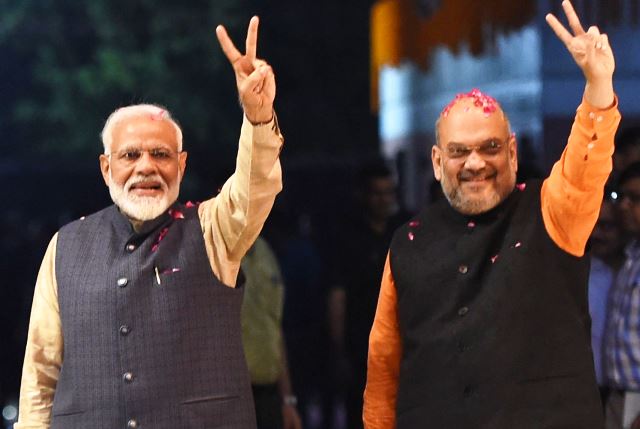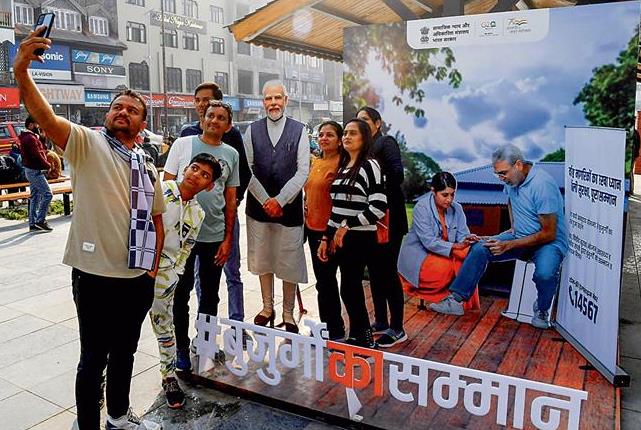It’s a phenomenon that has become so common that it is almost a part of the official protocol. When an incumbent administration has to announce a budget barely months before it seeks reelection, that budget invariably becomes a crowd pleasing one – full of sops, tax rebates, and other carrots that are proffered as enticement to voters. Last week, however, when the finance minister announced India’s interim budget, it was not especially laden with those customary come hither propositions. That’s because Prime Minister Narendra and his regime that is completing its second term and will be seeking a third at the elections, scheduled for April and May this year, expect that they will be a shoo-in for the voters.
In fact, to many it could seem that for Modi and his Bharatiya Janata Party (BJP), the elections will be a one-horse race. At the national level, opposition to the ruling regime is in shambles; the multi-party Indian National Developmental Inclusive Alliance (INDIA), which was formed last July, has all but disintegrated; and the BJP’s strength and prominence has grown without any signs of abatement.
The BJP has become so dominant that Modi’s government didn’t have to throw in sops or lollipops for voters in last week’s budget. Yes, it had the routine nods and doffs of the hat aimed at the poorest sections of the population: it has focussed on the rural sector and agriculture by boosting several schemes. Yet, it has also cut food subsidies, a delicate area, and not lowered income tax rates. In fact, it will lean on higher tax collections for the coming financial year.
In an election year, an interim budget lets an incumbent government spend until the new administration takes over. If the ruling regime is reelected it can seek approval for a full budget.
That eventuality looks like a certainty. Few doubt that the Modi regime can be ousted in the coming elections. For one, there seems to be no alternative to challenge it. Potential challengers have mainly self-destructed or become weakened. Some former challengers have crossed over to join the BJP or ally with it. Most recently, Nitish Kumar, Bihar’s longest lasting chief minister (last week he was sworn in for a record ninth time) jumped ship to join the National Democratic Alliance (NDA), which is led by the BJP. Ironically, Kumar was the main architect of the opposition alliance, I.N.D.I.A., formed with the sole purpose of ousting the Modi regime. Amen!
Kumar isn’t the only renegade in contemporary Indian politics to clamber aboard the BJP’s bandwagon. Politicians of all stripes from various opposition parties have jumped onto it. It may serve us well to remember that the word “bandwagon” was coined by Phineas T. Barnum, also known as P T Barnum, a famous 19th century American circus owner and showman. He created the term to describe the wagons that transported a circus band. The circus metaphor does fit Indian politics rather well.
Among those who have joined the BJP have been many of its erstwhile critics and sworn opponents. But then politics, at least in India, is marked by promiscuity. Some Congressmen who ditched their party to join the BJP have also been rewarded (or was it a quid pro quo?) by ministerial portfolios in Modi’s Cabinet. The current civil aviation minister, Jyotiraditya Scindia, 53, was in the Congress party for nearly 20 years before joining the BJP in 2020; and the minister for micro, small and medium enterprises, Narayan Rane, 71, also left the Congress to join the BJP in 2019. Rane is not a shy party-hopper. Before joining the Congress he was with the Shiv Sena.
There are many other political leaders, who were originally opposed to the BJP, but now members of that party. Jitin Prasad, 50, a longtime member of the Congress party who has also served as minister in the Congress regime, is now part of the BJP and a minister in the Uttar Pradesh government led by BJP’s Yogi Adityanath. In 2017, the veteran Congress leader from Karnataka, S.M. Krishna, once a foreign minister, joined the BJP. Other prominent politicians who have joined the BJP include the Assam chief minister Himanta Biswa Sarma, 55, who left the Congress in 2014; Mukul Roy, 69, who left the Trinamool Congress in West Bengal to join the BJP in 2017. In some states such as Uttar Pradesh, there have been televised events organised where opposition politicians have formally joined the BJP ceremoniously.
What makes the BJP a political lodestone in India? A simple answer to that is power. Politics, purists would say, is a pursuit of a calling rather than a career. In a democracy such as in India, the copybook definition of a politician’s ambition would be the urge to serve the people. However, in reality it is the power that politics can bestow on an individual and burnish his importance and status that drives many politicians.
The BJP won the elections and formed the government at the Centre in 2014 and has during the past 10 years decimated opposition at the national level. It is without doubt the most powerful political party in the country and one that offers the most potential for ambitious political leaders. In contrast, the Congress, once referred to as India’s Grand Old Party, is a weak shadow of itself. It has repeatedly lost elections at the Centre as well as in the states: in Parliament, the Congress now has 47 of the 543 seats. In 1984, when Rajiv Gandhi became Prime Minister, it had 414. His son, Rahul, now the party’s most prominent member, is witnessing the Congress’ steady and devastating decline. Of the 28 Indian states, the BJP rules 12 and is part of the ruling alliance in four more. The Congress is part of the ruling alliance in only five states.
The steady decline of the Congress’ importance and sway in Indian politics is one of the chief reasons why ambitious politicians from that party have been disillusioned and have decided to ditch it and join the Modi bandwagon. It is for the same reason that veteran politicians of regional parties such Nitish Kumar and his Janata Dal (United) have chosen to ally with Modi and bury earlier differences with him.
The BJP on its part has welcomed the influx of such renegades. First, many of the new entrants are leaders with considerable influence in their constituencies and can obviously beef up the BJP’s electoral might further. Second, their departure can also serve to weaken their former parties, which is good for the BJP. Some of the younger joinees have good track record as ministers–for instance Scindia or Prasad – and, therefore, can strengthen the BJP’s administrative firepower. They can also help win elections.
Meanwhile, the BJP has been quietly, and a bit invisibly, deepening and strengthening itself. It has become a significant force in Indian politics, and its appeal is multifaceted. While the party has been associated with Hindu nationalism and has been accused of being anti-minorities, it has also been successful in projecting an image of good governance and welfare schemes that appeal to a broad section of the electorate.
The BJP’s leadership, particularly Prime Minister Modi, is seen as strong and decisive, and the party has been successful in expanding its base and electoral presence. Last December, Modi retained his position as the world’s most popular leader with an approval rating of 76 per cent, as per the data released by US-based consultancy firm ‘Morning Consult’.
Additionally, the BJP’s well-oiled and lethal electoral campaign machine, which leaves nothing to chance, has been a significant factor in its success. The reasons for politicians leaving other parties to join the BJP may include disillusionment with their former party’s internal dynamics, leadership, and electoral prospects, but it is also the appeal of the BJP’s ideology, governance, and electoral success that has drawn them to it. Therefore, the BJP’s appeal is not limited to its association with Hindu nationalism, and it has been successful in projecting an image of good governance and welfare schemes that appeal to a broad section of the electorate.
Some observers feel that the BJP lacks a lineup of successors beyond Modi, 73, and home minister Amit Shah, 59, the two most prominent faces in the government. This may not be true. The party has a history of grooming and promoting leaders from within its ranks and is far less dynastic than many other India political parties such as the Congress or even regional parties where the route to leadership is often limited to those with family ties and connections.
Although some BJP leaders have been “sidelined”, including Shivraj Chouhan who was chief minister of Madhya Pradesh, Sushil Modi, who was deputy chief minister of Bihar, Vasundhara Raje, who was chief minister of Rajasthan for two terms, and Raman Singh, who served as chief minister of Chhattisgarh for 15 years, the BJP does have future leaders that it has been grooming.
Some of the younger leaders who have begun making a mark in the BJP and could be watched in the future include Himanta Biswa Sarma, who has emerged as the party’s point person in the north-east; Manoj Tiwari, 53, who the the Delhi BJP leader and whose influence has been growing; Tejasvi Surya, 33, an MP from Bangalore, known for his articulate speeches and strong conservative views; Poonam Mahajan, 43, another MP who is seen as a rising star in the party; and Sarbananda Sonowal, 61, an MP from Assam and currently a minister in the Modi cabinet.
These are just a few names of leaders to watch from the BJP. It will be worth the while to watch how these younger breen of party leaders are groomed and given more responsibility in the coming years. Also worth watching is how many more leaders from other parties make a beeline to what has become India’s most powerful political magnet.
For more details visit us: https://lokmarg.com/


